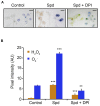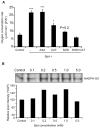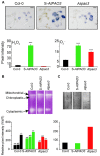Peroxisomal polyamine oxidase and NADPH-oxidase cross-talk for ROS homeostasis which affects respiration rate in Arabidopsis thaliana
- PMID: 24765099
- PMCID: PMC3982065
- DOI: 10.3389/fpls.2014.00132
Peroxisomal polyamine oxidase and NADPH-oxidase cross-talk for ROS homeostasis which affects respiration rate in Arabidopsis thaliana
Abstract
Homeostasis of reactive oxygen species (ROS) in the intracellular compartments is of critical importance as ROS have been linked with nearly all cellular processes and more importantly with diseases and aging. PAs are nitrogenous molecules with an evolutionary conserved role in the regulation of metabolic and energetic status of cells. Recent evidence also suggests that polyamines (PA) are major regulators of ROS homeostasis. In Arabidopsis the backconversion of the PAs spermidine (Spd) and spermine to putrescine and Spd, respectively, is catalyzed by two peroxisomal PA oxidases (AtPAO). However, the physiological role of this pathway remains largely elusive. Here we explore the role of peroxisomal PA backconversion and in particular that catalyzed by the highly expressed AtPAO3 in the regulation of ROS homeostasis and mitochondrial respiratory burst. Exogenous PAs exert an NADPH-oxidase dependent stimulation of oxygen consumption, with Spd exerting the strongest effect. This increase is attenuated by treatment with the NADPH-oxidase blocker diphenyleneiodonium iodide (DPI). Loss-of-function of AtPAO3 gene results to increased NADPH-oxidase-dependent production of superoxide anions ([Formula: see text] ), but not H2O2, which activate the mitochondrial alternative oxidase pathway (AOX). On the contrary, overexpression of AtPAO3 results to an increased but balanced production of both H2O2 and [Formula: see text] . These results suggest that the ratio of [Formula: see text] /H2O2 regulates respiratory chain in mitochondria, with PA-dependent production of [Formula: see text] by NADPH-oxidase tilting the balance of electron transfer chain in favor of the AOX pathway. In addition, AtPAO3 seems to be an important component in the regulating module of ROS homeostasis, while a conserved role for PA backconversion and ROS across kingdoms is discussed.
Keywords: Arabidopsis; NADPH-oxidase; ROS homeostasis; polyamine oxidases; polyamines; respiration.
Figures





References
LinkOut - more resources
Full Text Sources
Other Literature Sources

